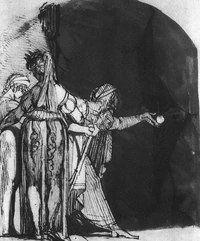
Perseus Returning the Eye of the Graiai, Henry Fuseli.
The Graeae (English translation: "old women", "grey ones", or "grey witches"; alternatively spelled Graiai (Γραῖαι) and Graiae) were three sisters who shared one eye and one tooth among them. They are one of several trios of archaic goddesses in Greek mythology. The Graeae were daughters of Phorcys and Ceto. Thus, they were among the Phorcydes, all of which were either aquatic (sea-based) or chthonic (earth-based) deities. The Graiae were sisters to the Gorgons.[1] The Graeae took the form of old grey-haired women; though, at times poets euphemistically described them as "beautiful." In other legends they are described as being half-swan.
Their age was so great that a human childhood for them was hardly conceivable. Hesiod reports their names as Deino (Δεινώ "dread", the dreadful anticipation of horror), Enyo (Ἐνυώ "horror" the "waster of cities" who also had an identity separate from this sisterhood) and Pemphredo (Πεμφρηδώ "alarm").[2] Hyginus adds a fourth, Persis (Περσις "destroyer, slayer") or Perso (Περσώ).
Like another set of crones at the oldest levels of both Germanic and Norse mythology, they shared one eye and one tooth, which they took turns using. By stealing their eye while they were passing amongst themselves, the hero Perseus forced them to tell the whereabouts of the three objects needed to kill Medusa (in other versions the whereabouts of Medusa herself), by ransoming their shared eye for the information.[1] One might compare the Graeae with the three spinners of Destiny, (the Moirai); the northern European Norns; or the Baltic goddess Laima and her two sisters; though all are distinct trios.[[
References[]
- Grimal, Pierre, "Graeae" p. 175
- Smith, William; Dictionary of Greek and Roman Biography and Mythology, London (1873). "Graeae"
- ↑ 1.0 1.1 Harris, Stephen L., and Gloria Platzner. Classical Mythology: Images and Insights (Third Edition). California State University, Sacramento. Mayfield Publishing Company. 2000, 1998, 1995, pp. 273-274, 1039.
- ↑ Hesiod. Theogony, 270-274, and Pseudo-Apollodorus, Bibliotheca ii.4.2; sometimes spelled Peuphredo (Πευφρηδώ) or Pephredo (Πεφρηδώ) (see M. Hofinger, Lexicon Hesiodeum cum Indice Inverso, p. 533.
External links[]
| This page uses content from the English Wikipedia. The original article was at Graeae. The list of authors can be seen in the page history. |